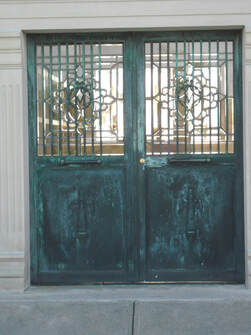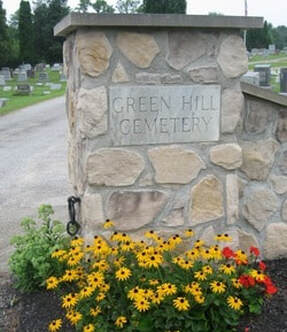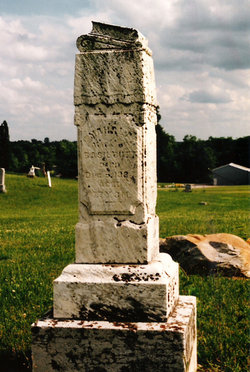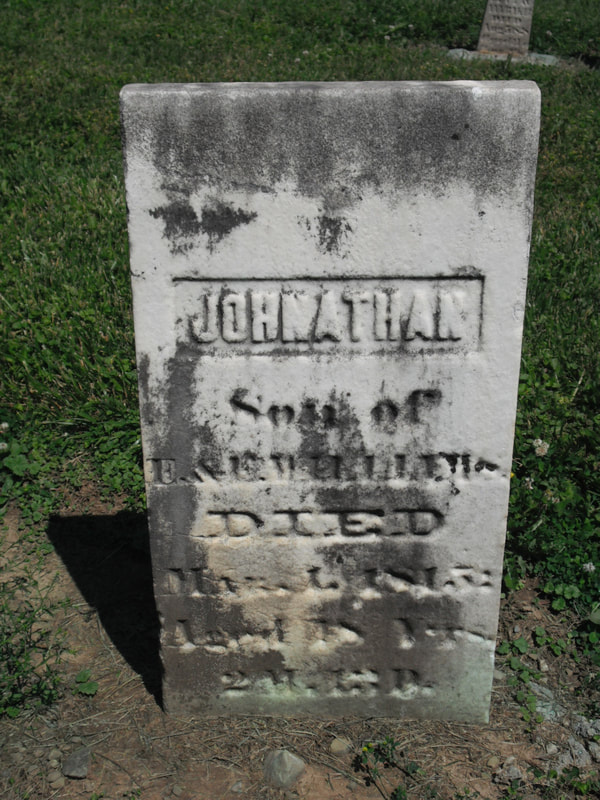Green Hill Cemetery - 7621 Johnstown-Alexandria Road, Johnstown, OH
DEVELOPMENT OF GREEN HILL CEMETERY
The original entrance to the cemetery is the one with the small white building on your left as you pull in from the State Route 37 highway. The first burial area seems to be this meadow area between the little white house and the Monroe Township meeting hall.
The older markers are actually to the right, with many of the early pioneers. Included here are the tablet markers of George Washington Evans who was the first white man to settle with his family in this area. Nearby is the upright column of Mahala (Green) Butt, the first white child born in this area. A large stone to the right of hers is designated as Basil Butt, her husband. Killed by a falling tree, he died elsewhere and his remains were moved here along with the nearby rock bearing the incident. Many of the older families are buried on this side of the older entrance roadway.
The cemetery grew from that small meadow and then gradually grew to the south, up onto the hills, back, and then down into this level area. On the other side of the same roadway up the hill to your left, you will find many of those who helped develop Johnstown in the nineteenth century. Perhaps it was a sign of prestige to have the hilltop sites. Markers vary in style and no one knows why. Each is a work of art and can be interpreted in several ways.
Often times families would buy a large section that could bury as many as twelve individuals. It is rough going finding someone in particular. Often times, you will simply stumble across someone who seems buried in the wrong place.
As sites became fewer, the remainder of those developers of the early twentieth century are on the level ground in front of the mausoleum. The farther you go back from the main highway, the more modern and newer stones. At this time deeds were reduced in size for a limit of four. This area with a flat surface makes for easier plotting and locating.
The original entrance to the cemetery is the one with the small white building on your left as you pull in from the State Route 37 highway. The first burial area seems to be this meadow area between the little white house and the Monroe Township meeting hall.
The older markers are actually to the right, with many of the early pioneers. Included here are the tablet markers of George Washington Evans who was the first white man to settle with his family in this area. Nearby is the upright column of Mahala (Green) Butt, the first white child born in this area. A large stone to the right of hers is designated as Basil Butt, her husband. Killed by a falling tree, he died elsewhere and his remains were moved here along with the nearby rock bearing the incident. Many of the older families are buried on this side of the older entrance roadway.
The cemetery grew from that small meadow and then gradually grew to the south, up onto the hills, back, and then down into this level area. On the other side of the same roadway up the hill to your left, you will find many of those who helped develop Johnstown in the nineteenth century. Perhaps it was a sign of prestige to have the hilltop sites. Markers vary in style and no one knows why. Each is a work of art and can be interpreted in several ways.
Often times families would buy a large section that could bury as many as twelve individuals. It is rough going finding someone in particular. Often times, you will simply stumble across someone who seems buried in the wrong place.
As sites became fewer, the remainder of those developers of the early twentieth century are on the level ground in front of the mausoleum. The farther you go back from the main highway, the more modern and newer stones. At this time deeds were reduced in size for a limit of four. This area with a flat surface makes for easier plotting and locating.

THE MAUSOLEUM
The Green Hill Mausoleum, built to hold 100 crypts and at a reported cost of $15,000, was dedicated on Nov. 18, 1917. The Honorable Congressman William A. Ashbrook presided over the short service that consisted of speeches by W. B. Childers and Hon. Beecher W. Waltermire, invocation and benediction by Rev. Homer Rice and three songs by the Heidelberg Quartette. The Independent (1917) summed up the feeling of the community: “The Mausoleum is surely a monument to the builder and those who purchased the crypts. Let us hope that it will be as enduring as time”.
The Mausoleum anchors the lower level of Green Hill Cemetery which began on the hills to the north. Directly opposite the current stone gate, this formidable sandstone structure has a B.C. Biblical appearance. Clues to the Trinity are found in its three-part façade, which is repeated within above the door and opposing wall. The metallic jail-like door shows an inverted torch which probably represents a physical death or feelings of one in mourning. The panes above the only door show a cross between two candles, reminiscent of an altar. You realize then that this place, built on an east-west axis, has the healing powers of a temple. The morning sun arrives on the entrance side and the western wall has three windows of stain glass and torches. These are beautiful at sunset, a common metaphor for death. The interior might suggest the area inside a coffin: long and narrow with a rounded lid, yet the darkness is not there. The light gray floor tiles, the light-colored marble walls, the hidden upper windows, and rounded barrel ceiling reduce the sense of darkness and confinement. This Mausoleum is an architectural gem.
The Green Hill Mausoleum, built to hold 100 crypts and at a reported cost of $15,000, was dedicated on Nov. 18, 1917. The Honorable Congressman William A. Ashbrook presided over the short service that consisted of speeches by W. B. Childers and Hon. Beecher W. Waltermire, invocation and benediction by Rev. Homer Rice and three songs by the Heidelberg Quartette. The Independent (1917) summed up the feeling of the community: “The Mausoleum is surely a monument to the builder and those who purchased the crypts. Let us hope that it will be as enduring as time”.
The Mausoleum anchors the lower level of Green Hill Cemetery which began on the hills to the north. Directly opposite the current stone gate, this formidable sandstone structure has a B.C. Biblical appearance. Clues to the Trinity are found in its three-part façade, which is repeated within above the door and opposing wall. The metallic jail-like door shows an inverted torch which probably represents a physical death or feelings of one in mourning. The panes above the only door show a cross between two candles, reminiscent of an altar. You realize then that this place, built on an east-west axis, has the healing powers of a temple. The morning sun arrives on the entrance side and the western wall has three windows of stain glass and torches. These are beautiful at sunset, a common metaphor for death. The interior might suggest the area inside a coffin: long and narrow with a rounded lid, yet the darkness is not there. The light gray floor tiles, the light-colored marble walls, the hidden upper windows, and rounded barrel ceiling reduce the sense of darkness and confinement. This Mausoleum is an architectural gem.


